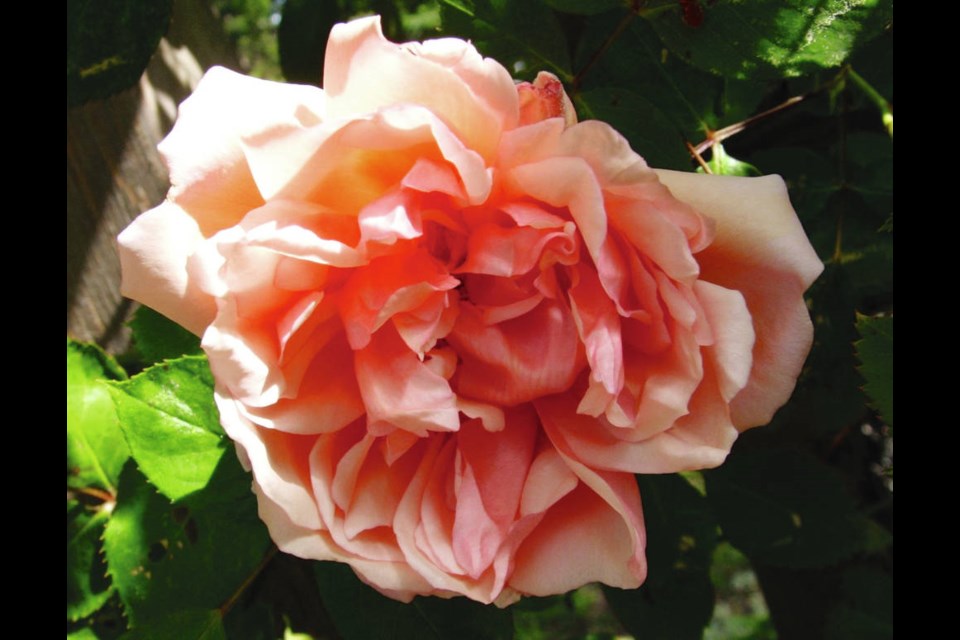Dear Helen: I have a sweetheart rose that is awkwardly located next to my front steps. It blooms well in early summer, but it grows rapidly to cover the steps unless I keep cutting it back. How and when should I prune this plant? Should it be cut right down, or would it be best to dig it up and choose something more appropriate for the space? Though not remarkably attractive when out of bloom, the rose does provide a green screen, pleasant when we sit out on the front porch.
L.M.
You have the climbing form of Cecile Brunner. The parent plant, known as the sweetheart rose, is a dainty little (120-cm) plant that has charmed gardeners since its introduction in 1881. The shrub bears an abundance of small, exquisitely formed, shell pink flowers. It was a favourite rose in Victorian gardens.
The climbing form bears the same flowers, but on a very vigorous climber that is ideal for growing up into trees. Several times, my long-established plant had become so overgrown that I’ve had to enlist help in thinning out the plant to leave just a few of the newest, youngest canes.
Several options are open to you. One is to prune rigorously right after the flowering period, early every summer. These roses bloom mainly on wood produced in the previous year. If you prune to remove at their bases or at ground level most of the canes that have just produced flowers, you’ll be left with a more easily contained plant with mostly new growth that will bloom the following year.
If you prefer to have the plant gone entirely from beside the front steps, and it’s a fairly young plant, it could be dug up and replanted in a more appropriately roomy location.
If you decide to opt for a different plant to grow in place of the rose, renovate the vacated patch of soil thoroughly, digging out roots and debris and replenishing the area by incorporating a nourishing compost. Aim to plant a chosen specimen in late winter or early spring.
Help at local nurseries and garden centres is invaluable in finding an ideal plant for a particular location. Deciding on a plant can be made fairly simple if you have a clear idea of the features you want. Some questions to ask yourself:
* What ultimate height and width would best fit the space?
* What sort of form is your preference — thick and bushy, or more spaced and airy? Rounded, pyramidal, narrowly upright?
* Deciduous or evergreen? If you want a leafy screening for the porch only in summer, choose a deciduous plant.
* Are flowers essential? How important is fragrance to you?
Dear Helen: I have an old rambler rose — Albertine, I think — that is much admired by friends when it is in full early summer bloom. Can these roses be propagated from cuttings? I’d love to have young, newly rooted plants to give away.
R.L.
Ramblers can be propagated by cuttings. My own Albertine rose was a cutting-grown gift.
Various methods and timings for taking and rooting rose cuttings are promoted. The process I’ll pass along to you is one the late Doris Page, a longtime prominent gardening expert and mentor in the Victoria area, described for me in a letter.
Doris successfully rooted cuttings of “climbing rambler type” roses, as well as miniature roses, using “flowered pieces,” that is stems bearing recently withered blooms. For each cutting, she first removed the faded flower and its stem before shortening the cutting to about 10 cm with the bottom cut right beneath a leaf node. All but the top tuft of leaves are removed.
Once the cuttings were trimmed, Doris dipped the ends in a rooting powder and inserted them around the rim of a 10-cm wide clay pot filled with coarse sand. A lightweight, porous potting mix could also be used.
She then sank the pot into a bed of sand on a bench in her shady greenhouse. Doris did not arrange a plastic “humidity tent” over the cuttings, but she did keep them modestly watered.
Doris commented in her letter that the cuttings would probably root well inserted into a shaded garden spot that is kept watered.
Albertine is a famous old rambler that is easy-growing and vigorous. The richly perfumed flowers are a beautiful coppery-pink and gold.



